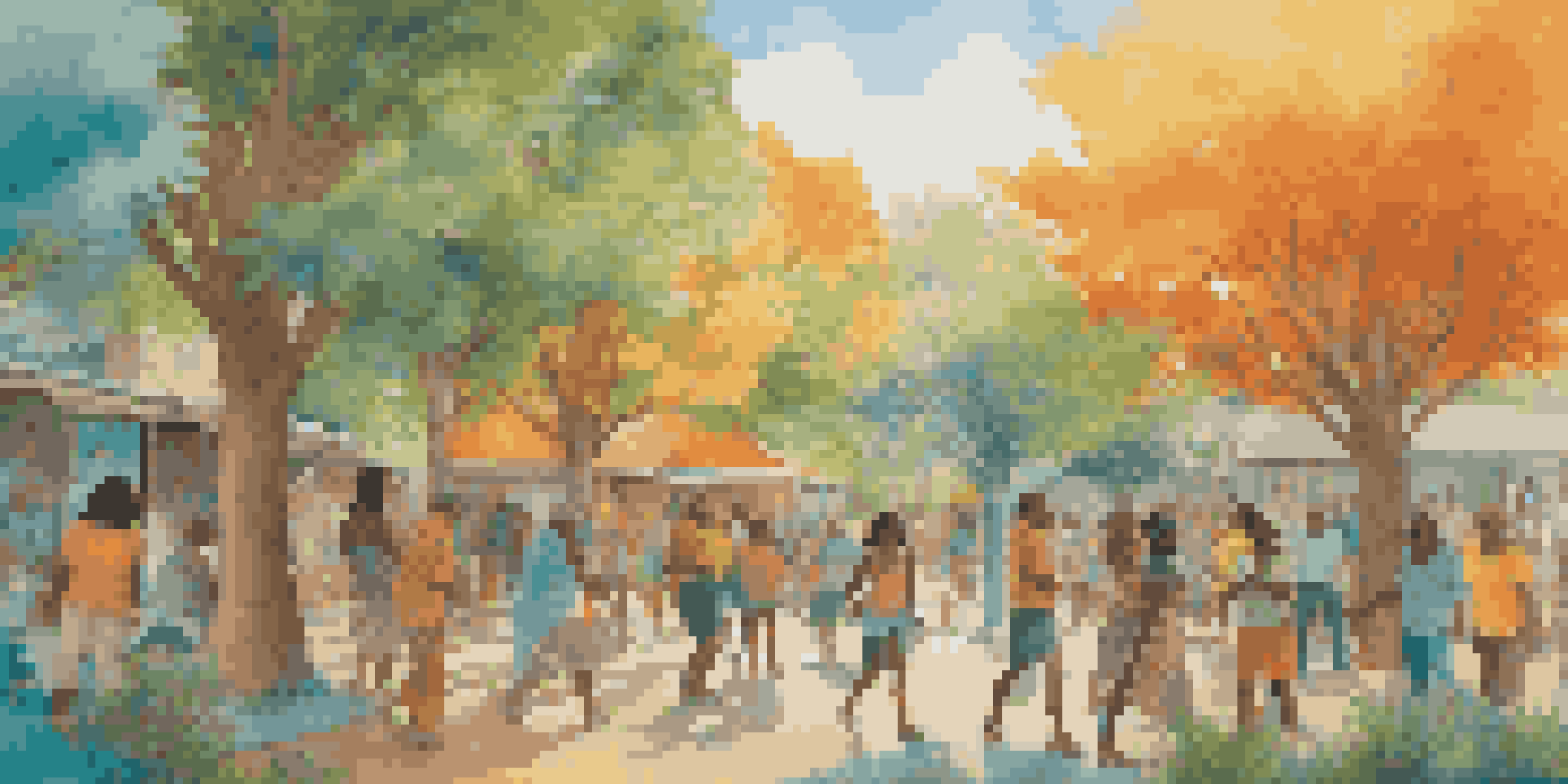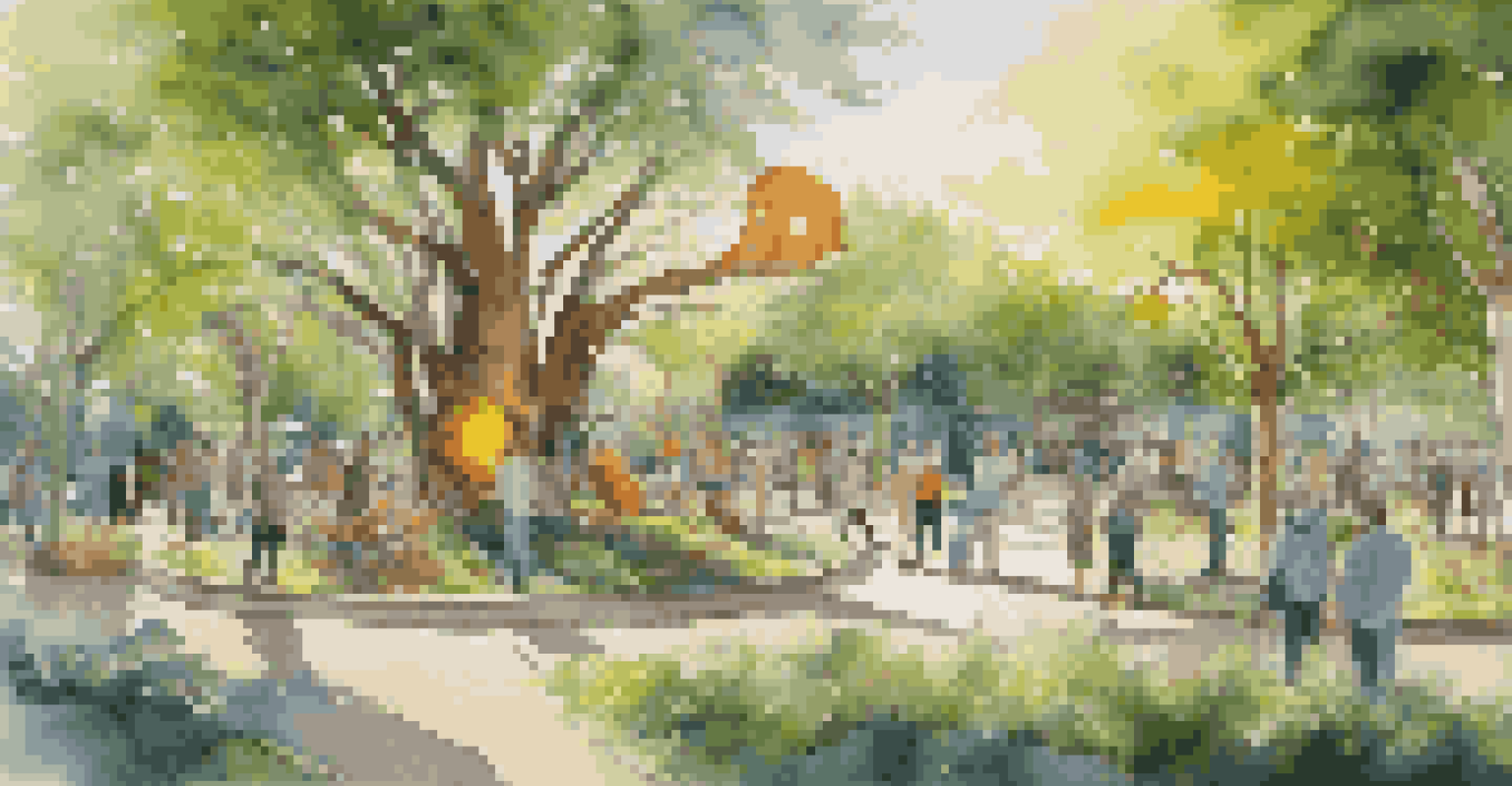The Significance of Art in Addressing Global Challenges

Art as a Catalyst for Social Change and Awareness
Art has the remarkable ability to inspire social change and raise awareness about pressing issues. Through various forms, such as paintings, music, and performances, artists can communicate powerful messages that resonate with audiences. For instance, the iconic 'Guernica' by Pablo Picasso starkly depicts the horrors of war, prompting viewers to reflect on the impact of violence.
Art is not a mirror to reflect the world, but a hammer with which to shape it.
Moreover, art can serve as a vehicle for marginalized voices, amplifying their stories and struggles. This representation not only fosters empathy but also encourages dialogue and understanding among diverse communities. When people engage with art that reflects their realities, it can ignite movements for change and motivate collective action.
By engaging with art, individuals are often inspired to take action in their own communities, whether through volunteering, advocacy, or simply raising awareness. Just as a single brushstroke can change a canvas, one piece of art can shift perspectives and inspire a wave of change.
Art's Role in Environmental Advocacy
In an era of climate change and environmental degradation, art plays a crucial role in advocating for the planet. Artists often use their platforms to highlight the beauty of nature while also addressing the consequences of human actions. For example, installations made from recycled materials can provoke thought about waste and sustainability.

Moreover, public art projects, such as murals or sculptures, can transform urban spaces into reminders of our environmental responsibilities. These artworks invite viewers to engage with their surroundings and consider their impact on the earth. When art is placed in public contexts, it becomes a communal call to action.
Art Drives Social Change
Art inspires action and dialogue, amplifying marginalized voices and igniting movements for change.
Additionally, art can act as a bridge to scientific understanding, making complex environmental issues more accessible. By visualizing data or scientific concepts in creative ways, artists help demystify the science behind climate change, encouraging broader public engagement and understanding.
Fostering Community and Connection Through Art
Art has the unique ability to bring people together, fostering a sense of community and connection. Community art projects often encourage collaboration among individuals with diverse backgrounds, creating a shared sense of purpose. When people work together on artistic endeavors, they build relationships that can lead to stronger, more resilient communities.
The power of art is not to change the world, but to change how we see the world.
For instance, neighborhood murals can reflect local culture and history, instilling pride among residents. These projects not only beautify public spaces but also serve as a canvas for storytelling, allowing communities to express their identity. This sense of belonging is crucial in addressing social isolation, a challenge many face today.
Furthermore, art can provide a safe space for dialogue and healing, especially in times of crisis. Workshops and art therapy sessions can offer individuals an outlet for their emotions, helping them process their experiences and connect with others who may share similar struggles.
Art as a Tool for Education and Awareness
Education is a powerful tool in addressing global challenges, and art can enhance educational experiences in profound ways. By integrating art into educational curricula, students can engage with complex topics more creatively and memorably. For example, using drama to explore historical events can make learning more immersive and relatable.
Moreover, art can simplify intricate subjects, making them more accessible to a wider audience. Visual aids, such as infographics or animations, can break down scientific concepts or social issues, helping people grasp essential information quickly. This approach can be particularly effective in raising awareness about global challenges, from health crises to human rights.
Art's Role in Environmental Awareness
Through creative expression, art highlights environmental issues, making complex topics more accessible to the public.
Additionally, art encourages critical thinking and empathy, skills vital for addressing the multifaceted issues we face today. By analyzing and creating art, individuals develop a deeper understanding of different perspectives, fostering a more compassionate and informed society.
The Economic Impact of Art in Global Solutions
Art isn't just a cultural asset; it also has significant economic implications that can aid in solving global challenges. The creative industry creates jobs and stimulates local economies, contributing to community development and sustainability. For instance, art festivals can attract tourism, benefiting local businesses and generating income for artists.
Moreover, investing in the arts can lead to innovation and entrepreneurship, driving social change. Many social enterprises leverage art to address issues like poverty and education, creating sustainable solutions that empower communities. By supporting artists and creative initiatives, stakeholders can foster environments where new ideas flourish.
Additionally, art can be a means of fundraising for causes, as seen in charity auctions or benefit concerts. These events not only raise money but also increase awareness about vital issues, demonstrating the powerful intersection of art and social responsibility.
Art and Mental Health: A Healing Force
The connection between art and mental health is profound, with creative expression often serving as a therapeutic outlet. Engaging in artistic activities can reduce stress, anxiety, and depression, providing individuals with a means to process their emotions. This healing aspect of art is especially crucial in times of crisis, where mental health challenges may intensify.
Art therapy, for instance, is a recognized form of treatment that allows individuals to explore their feelings through creative expression. This approach can be particularly beneficial for those who find verbal communication difficult. By creating art, individuals can convey feelings and experiences that may be hard to express in words.
Art Fosters Community Connection
Community art projects bring people together, creating a shared sense of purpose and belonging.
Moreover, community art initiatives can foster a sense of belonging and support, crucial for mental well-being. When people come together to create, they build connections and share experiences, creating a network of support that can significantly impact mental health.
Harnessing Technology to Amplify Art's Impact
In today's digital age, technology has transformed how art is created, shared, and experienced. Artists can now reach global audiences through social media platforms, allowing their messages to resonate far beyond their local communities. This connectivity enables artists to raise awareness about global challenges on an unprecedented scale.
Furthermore, technology enhances artistic expression, enabling new forms of creativity and collaboration. Virtual reality, for instance, allows viewers to immerse themselves in artistic experiences that provoke thought and emotion. Such innovative approaches can engage individuals in discussions about important issues, making art a tool for advocacy.

Additionally, online platforms can facilitate community engagement through virtual workshops and exhibitions. This accessibility allows people from various backgrounds to participate, ensuring that art remains a universal language for addressing global challenges.